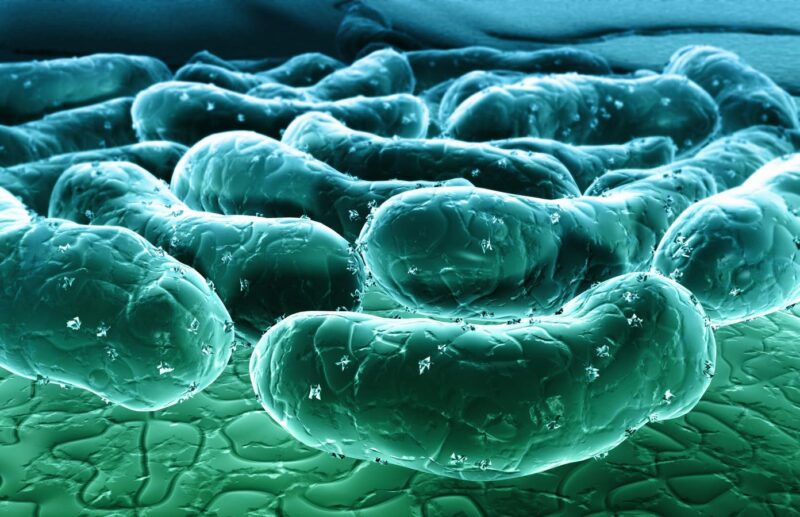What the science says about how gut bacteria influences metabolism and chronic disease risk
Stylized conceptual image of gut bacteria.
getty
Your gut microbiome may be an even stronger predictor of health than your genes, shaping everything from weight and metabolism to brain health and aging
Why Your Gut Bacteria Matter More Than You Think
Metabolism is often reduced to a simple equation of calories in versus calories out. Yet research increasingly shows that the trillions of microbes that make up your gut microbiome add another dimension to the equation, shaping how food is digested, how energy is extracted, and how nutrients influence weight and overall health.
What is becoming even more striking is that the microbiome’s reach goes far beyond metabolism. Alzheimer’s disease now affects more than 55 million people worldwide, and Parkinson’s disease nearly nine million, with numbers projected to rise steeply in the coming decades. These conditions, along with cardiovascular disease, the leading global killer, have all been linked to dysbiosis, meaning an imbalance in gut microbes. Intriguingly, some studies suggest that microbiome changes can appear years before clinical symptoms, raising the possibility that microbial signatures could one day serve as predictive biomarkers or even targets for preventive therapies.
A Deeper Look: Scale of Your Microbiome
Your gut microbiome is staggering in scope. Over 30 trillion microbes live inside you, roughly equal in number to your own human cells. Wherever our body interfaces with the outside world, there is a microbiome: skin, nose, mouth, and most importantly, the gut.
You can think of the microbiota as the players in a sporting event, the actual microbes living in us, and the microbiome as everything in the stadium, encompassing the players, their genes, and their interactions with each other and the environment. Together these elements ultimately shape the gut ecosystem.
Colonization begins at birth. Vaginally delivered infants acquire microbes from their mother’s vaginal and intestinal communities, while those born by cesarean section often start with skin and environmental microbes. Early colonizers, come from mothers, caregivers, and even pets, and help train the immune system and may shape metabolic and allergy risk later in life. Breastfeeding further enriches the microbiome with human milk oligosaccharides that selectively feed beneficial bacteria.
The microbiome is not static, however. It shifts in response to environmental exposures such as diet, antibiotic use, infections, stress, and even pollutants. These influences can either enrich microbial diversity or reduce it, tipping the balance toward resilience or vulnerability depending on the context.
Evolution of Your Microbiome
For over three billion years the earth was dominated by microbes. More recently multicellular eukaryotes evolved to live with them. The symbiotic relationships that nearly all multicellular organisms maintain with microbes reflect this long co-evolution.
The Human Microbiome Project (2008–2012) used sequencing technology from the Human Genome Project to create the first comprehensive reference map of microbial communities. The gut “gene catalog” is estimated at over 3 million microbial genes, roughly 150 times larger than the human genome, underscoring the functional capacity of our microbiome relative to our human DNA. The trillions of microbial cells give the microbiome its scale and ecological dynamics, but the millions of genes are what define its functional toolkit.
Unlike our human cells, which are eukaryotic and bound by slower evolutionary rules, microbes can divide, mutate, and adapt at breathtaking speed. Over human history, that adaptability has been both a gift and a liability. Analyses of Ötzi the Iceman, a 5,300-year-old mummy found in the Alps, revealed a gut microbiome with far greater diversity than that of most modern humans. Researchers used paleomicrobiome analysis of his mummified gut contents, which preserve DNA far more reliably than fossilized coprolites, allowing scientists to sequence ancient microbial DNA and reconstruct a snapshot of his intestinal ecosystem (Cell Genomics, 2023).
What was once the norm in Ötzi’s time has become the exception today. Industrialized diets, antibiotics, and highly processed foods have steadily eroded the richness of our gut ecosystems. The conveniences of modern living have come at a hidden cost: the loss of microbial partners that once supported immunity, balanced inflammation, and helped regulate metabolism.
The microbiome can shift in weeks or even days, while our human cells can only evolve over many generations. Human cells adapt through epigenetics, which involves changes in gene expression that switch certain pathways on or off. The microbiome, by contrast, evolves outright. New strains appear, mutate, and compete. Sometimes that rapid evolution benefits us by protecting metabolism; other times it works against us, fueling inflammation, obesity, or chronic disease. In effect, your microbiome is a fast-moving evolutionary system living inside a slow-moving human host.
Meet Your Microbes
In the colon, trillions of organisms form a dense biofilm that makes up more than 30 percent of fecal mass. These are not just bacteria but also archaea, fungi, and viruses, all contributing to a complex ecosystem.
Different species perform very different jobs. Butyrate producers such as Faecalibacterium prausnitzii and Roseburia help fuel colon cells, reinforce the gut barrier, and temper inflammation. Akkermansia muciniphila resides in the mucus layer itself, helping keep it thick and functional, which is especially critical given that the intestinal barrier is only a single cell layer thick. It also produces a protein known as P9, which stimulates GLP-1 release and may contribute to improved glucose regulation and metabolic health.
Other genera are widely considered protective because of their metabolic outputs. Bifidobacterium ferments dietary fibers into acetate and lactate, which other microbes can then convert into butyrate, indirectly supporting barrier strength and immune balance. Lactobacillus species produce lactic acid, lowering gut pH in ways that discourage overgrowth of harmful bacteria and modulate immune activity. Both groups are also capable of producing bioactive compounds that reduce intestinal inflammation.
Not all microbes play on the same team. Methanogenic archaea such as Methanobrevibacter smithii consume hydrogen and generate methane, which slows intestinal transit. Species like Ruminococcus gnavus are adept at degrading mucin, and in excess can thin the protective mucus barrier, exposing the fragile epithelium. Certain Clostridium species and some strains of Escherichia coli can act as pathobionts, normally tolerated but harmful when they overgrow or colonize the small intestine.
Some microbes also shape metabolism through bile acid transformations. Clostridium scindens is particularly notable for converting primary bile acids into secondary forms, which act as potent signaling molecules and can stimulate GLP-1 secretion, influencing glucose control and appetite regulation.
The micro-geography of the gut is also important. Each region presents a distinct environment. It is acidic in the stomach, alkaline in the small intestine, and anaerobic in the colon. Bile acids, motility, and nutrient gradients all influence which microbes thrive where. Further, microbes that settle into crypts or protected niches may have a competitive advantage and be particularly hard to remove.
The gut ecosystem is therefore not uniform but a dynamic mix of allies and potential antagonists. Some species reinforce the barrier and generate metabolites that benefit their host, while others weaken defenses or tip metabolic signals in unhealthy directions. The balance among them sets the stage for resilience or dysfunction.
Evidence Spotlight: Artificial Sweeteners and Hidden Calories
Research suggests that some gut microbes may partially metabolize certain artificial sweeteners, sugar alcohols, and processed food additives. For example, studies in Nature (2014) found that saccharin altered microbial composition in both mice and humans, promoting glucose intolerance in susceptible individuals. More recent work in Cell (2022) showed that sucralose and aspartame can be variably metabolized by human gut microbes, leading to shifts in glycemic responses that differ from person to person. While these compounds are generally labeled as “non-caloric,” the reality is that microbial activity may extract some energy or trigger metabolic effects not captured on food labels. This highlights how the microbiome can act as an unseen variable in the true caloric and metabolic cost of processed foods.
Dysbiosis and Chronic Disease
Dysbiosis refers to an imbalance in the gut microbiome, where beneficial and harmful species fall out of equilibrium. This can mean a loss of protective bacteria, an overgrowth of pathobionts (microbes that cause harm when uncontrolled), microbes colonizing areas where they are not normally found, or a reduction in overall microbial diversity. Dysbiosis has been linked to a wide range of conditions, from obesity and type 2 diabetes to autoimmune disease, cardiovascular disease, neurological disorders, and mood disturbances.
One of the best studied downstream effects of dysbiosis is increased intestinal permeability, often described colloquially as “leaky gut.” At the cellular level, this involves loosening of tight junction proteins such as occludin and claudins, thinning of the protective mucus layer, and shifts in immune signaling. Because the epithelial barrier is only a single cell layer thick, the mucus is a critical shield. If it thins, microbes and their products can come into direct contact with the lining, raising the risk of inflammation and disease. Elevated levels of zonulin, a regulator of tight junctions, have been documented in conditions ranging from celiac disease to type 1 diabetes.
When the gut barrier becomes more permeable, bacterial fragments such as lipopolysaccharides (LPS) and other microbial metabolites can cross into circulation. This translocation triggers low-grade systemic inflammation, also called metabolic endotoxemia. A landmark study in Diabetes (2007) demonstrated that high-fat diets in mice increased circulating LPS, which in turn drove insulin resistance and weight gain. Human studies have echoed these findings, linking elevated LPS levels with obesity, nonalcoholic fatty liver disease, and metabolic syndrome.
Cardiovascular disease, the leading global cause of death, has also been tied to dysbiosis through microbial metabolites such as trimethylamine N-oxide (TMAO). Elevated TMAO levels, produced when gut microbes metabolize dietary choline and carnitine, have been linked with higher risks of heart attack and stroke.
Methanogenic archaea, particularly Methanobrevibacter smithii, represent another important facet of dysbiosis. These organisms consume hydrogen produced during fermentation and generate methane. Excess methane has been strongly associated with constipation-predominant irritable bowel syndrome (IBS-C) and with slower intestinal transit. Small intestinal bacterial overgrowth (SIBO) involving archaea is often termed intestinal methanogen overgrowth, highlighting their distinct role in gut dysfunction.
The gut-brain connection adds further complexity. Large human cohort studies show that people with major depressive disorder often harbor reduced levels of butyrate-producing taxa such as Faecalibacterium and Coprococcus (Nature Microbiology, 2019). In animal models, fecal microbiota transferred from patients with depression into germ-free mice induced depressive-like behaviors, supporting a causal gut-to-brain pathway. Small randomized trials of probiotics and prebiotics in humans have reported modest symptom improvements, while Mediterranean-style diets enriched in fiber and polyphenols appear to reduce depressive symptoms more robustly.
Gut brain connection
getty
Neurodegenerative diseases are another frontier. In Parkinson’s disease, reduced levels of Prevotella and increases in Enterobacteriaceae have been repeatedly observed, with altered microbial metabolites linked to motor symptoms and inflammation (Movement Disorders, 2014). For Alzheimer’s disease, microbial shifts that increase pro-inflammatory species and reduce short-chain fatty acid producers have been reported. Intriguingly, some studies show that microbiome changes can appear years before clinical symptoms.
Autism spectrum disorder (ASD) has also been associated with dysbiosis. Numerous studies describe increased abundances of Clostridium, Lactobacillus, and Faecalibacterium, alongside decreases in Bifidobacterium, Enterococcus, and Streptococcus. Recent milestone studies have even demonstrated causal relations. When gut microbiota from children with ASD were transplanted into germ-free mice, the animals developed ASD-like behaviors, suggesting microbial metabolites as key contributors to the disorder (Nature Communications, 2025).
While some wellness narratives overstate claims about “leaky gut,” the core biology of dysbiosis, barrier dysfunction, and systemic signaling is supported by credible science across multiple diseases. The emerging picture is that disruptions in the gut ecosystem may shape not only digestion and metabolism but also cardiovascular, neurologic, and mental health.
Conditions Linked to Dysbiosis
Metabolic Health
– Obesity, insulin resistance, and type 2 diabetes
– Nonalcoholic fatty liver disease, linked to systemic inflammation
Cardiovascular Health
– Heart attack and stroke risk, associated with elevated TMAO levels
Gut Function
– Constipation-predominant IBS and slowed transit, associated with methanogenic archaea (Methanobrevibacter smithii)
– Small intestinal bacterial overgrowth (SIBO) and intestinal methanogen overgrowth
Neurological and Cognitive Health
– Parkinson’s disease, linked with reduced Prevotella and higher Enterobacteriaceae
– Alzheimer’s disease, associated with loss of short-chain fatty acid producers and inflammatory shifts
– Autism spectrum disorder, with altered microbial communities and causal evidence from germ-free mouse models
Mental Health
– Major depressive disorder, linked to reduced butyrate-producing taxa such as Faecalibacterium and Coprococcus
How Diet Shapes Your Microbiome
Diverse, plant-based, polyphenol-rich rich foods.
getty
The most powerful way to influence your gut bacteria is not a pill but your daily diet. Research consistently shows that fiber is key. High-fiber foods encourage microbes that produce short-chain fatty acids, which in turn improve insulin sensitivity and lower inflammation. Diversity matters as well. Eating a wide range of plant foods fosters a richer microbiome, and large cohort studies link this microbial diversity to better metabolic health (Science, 2018).
Resistant starches are one especially important dietary factor. These carbohydrates escape digestion in the small intestine and reach the colon intact, where microbes ferment them into beneficial metabolites such as butyrate. Butyrate is critical fuel for colon cells, strengthening gut barrier integrity and regulating tight junction proteins. Elevated zonulin, a regulator of those junctions, has been observed in conditions ranging from celiac disease to type 1 diabetes, underscoring the importance of supporting barrier function.
Types of resistant starch include raw potatoes and green bananas (RS2), cooked and cooled rice, oats, or potatoes where starch has retrograded (RS3), and chemically or lipid-modified starches studied in research settings (RS4 and RS5). Human trials have linked resistant starch intake to increased butyrate production, improved insulin sensitivity, and reduced systemic inflammation. These effects appear especially relevant for people at risk of metabolic disease or barrier dysfunction.
Fermented foods add another complementary strategy. Yogurt, kefir, kimchi, sauerkraut, and similar foods deliver live microbes and bioactive compounds directly. In a controlled clinical trial at Stanford (Cell, 2021), participants assigned to a fermented foods diet for 10 weeks showed significant increases in microbial diversity and decreases in inflammatory markers compared to those assigned to a high-fiber diet alone. This suggests that fermented foods may amplify the benefits of fiber by enriching microbial communities while also tempering inflammation.
Polyphenol-rich foods add another layer of benefit. Fruits such as apples, pomegranate, and berries, along with beverages like green tea and red wine in moderation, have been shown in both animal models and early human studies to selectively increase Akkermansia muciniphila. Catechins, the dominant polyphenols in green tea, are especially powerful. They have been shown to promote Akkermansia growth, modulate bile acid metabolism, and reduce systemic inflammation (Journal of Nutritional Biochemistry, 2020).
Together, fiber, resistant starches, fermented foods, and polyphenols form a dietary toolkit that can meaningfully shift the microbiome toward a healthier state. But while diet can shift the microbiome rapidly, the bigger question is whether those changes last.
Dietary Habits That Boost or Block Akkermansia
Support Akkermansia
– Polyphenol-rich foods such as berries, apples, pomegranate, green tea, and red wine in moderation
– Pectin-rich fruits like apples, pears, and citrus
– Prebiotic fibers from onions, garlic, asparagus, and chicory root
– Resistant starch from cooked and cooled potatoes, rice, oats, and green bananas
– Plant-diverse diets such as the Mediterranean pattern
Suppress Akkermansia
– Diets high in ultra-processed foods and low in fiber
– Chronic antibiotic use
– Limited intake of polyphenols and fermentable fibers
Can You Really “Upgrade” Your Microbiome?
“Upgrading your microbiome” has become a popular phrase in wellness circles, but the reality is more complex. The microbiome is malleable, yet it tends to gravitate toward a stable state. Short-term dietary changes can produce rapid shifts, with dramatic differences appearing within days on all-plant versus all-animal diets. Unless those changes are sustained, the microbial community usually reverts.
Rodent research highlights how fragile and persistent these patterns can be. In a landmark study, mice born to mothers fed a high-fat, low-fiber diet lost microbial diversity that did not fully recover, even when fiber was restored in later generations (Cell Host & Microbe, 2022). Human studies mirror this stickiness. While dramatic dietary shifts create quick changes, the microbiome often returns to baseline once people resume their habitual diet.
The lesson is clear. The microbiome can be upgraded, but only with long-term commitment. A sustained pattern of diverse, fiber- and polyphenol-rich foods, coupled with limited ultra-processed intake, is what maintains beneficial shifts. Short-term cleanses or drastic interventions rarely achieve lasting change.
The bottom line: you can upgrade your microbiome, but it requires long-term commitment to fiber-rich, diverse, minimally processed foods.
The Future: Microbiome-Targeted Therapies
The idea of treating obesity, metabolic disease, and even neurological disorders with microbial therapies is moving from concept to clinic. Some approaches are already being tested in rigorous human trials, while others remain on the horizon.
What is happening now:
Precision probiotics are the closest to reality. Akkermansia muciniphila is the leading example. Observational studies involving thousands of participants show that higher levels are consistently linked with lower rates of obesity and metabolic syndrome (Nutrition & Metabolism, 2020). More importantly, double-blind, placebo-controlled trials have begun to test supplementation directly. In Nature Medicine (2019), overweight and insulin-resistant adults who received pasteurized Akkermansia for three months improved insulin sensitivity, cholesterol, and inflammatory markers, with modest reductions in weight and fat mass. More recent work in Cell Metabolism (2024) has reinforced these benefits. While results are encouraging, supplementation remains experimental and is not yet approved therapy.
Live biotherapeutic products (LBPs) are another active area. These are formally recognized by the FDA as living organisms developed as drugs to prevent, treat, or cure disease. Companies such as 4D Pharma have received FDA clearance to test LBPs in Parkinson’s disease, reflecting the expansion of microbiome science beyond metabolism into neurology.
Emerging therapies:
Researchers are also exploring microbial metabolites such as butyrate as potential therapeutics, engineered probiotics designed to perform specific functions, and fecal microbiota transplants (FMTs). FMT is validated for some recurrent infections but remains experimental for metabolic or neurological health. One of the most intriguing leads is the Akkermansia-derived protein P9, which boosts GLP-1 secretion in animal models. Biotech groups are now experimenting with engineered bacteria that secrete P9 or with purified recombinant P9, offering a way to harness microbial proteins for metabolic benefit.
For Alzheimer’s and Parkinson’s disease, several studies suggest that microbiome changes appear before clinical symptoms emerge, raising the possibility of predictive biomarkers, as well as the possibility of intervening early with LBPs or engineered strains.
Conceptualized image of capsule-based technology to sample and analyze the gut microbiome
getty
Beyond adding microbes or their products, the next wave of progress will depend on diagnostics and personalization. Stool sequencing, shotgun metagenomics, and capsule-based devices that sample different regions of the gut are emerging as tools to phenotype the microbiome more precisely. This may allow therapies to be matched to each individual’s microbial profile. One example is MRM Health which has partnered with Nimble Science and the Calgary Parkinson’s Research Initiative to use an ingestible capsule to sample small-intestinal microbiome content, generating data to guide future LBPs for Parkinson’s.
Nevertheless, the likely future is not one-off resets but integrated programs that combine diet, lifestyle, precision diagnostics, and microbial therapeutics tailored to each person’s biology.
The Bottom Line for Readers
The science is evolving, but one thing is already clear: your microbiome is a major player in your metabolism and overall health. While future therapies are on the horizon, you can take practical steps today:
- Prioritize high-fiber, plant-diverse diets
- Include resistant starch sources such as cooled potatoes, rice, or green bananas
- Add polyphenol-rich foods like berries, apples, pomegranate, and green tea
- Incorporate fermented foods, including yogurt, kefir, kimchi, and sauerkraut, which clinical studies show can increase microbial diversity
- Limit ultra-processed foods
- Support microbial diversity through long-term lifestyle choices
By feeding the right microbes, you are not just improving digestion, you are shaping your microbiome in ways that support metabolism, stabilize weight, and lower disease risk.









